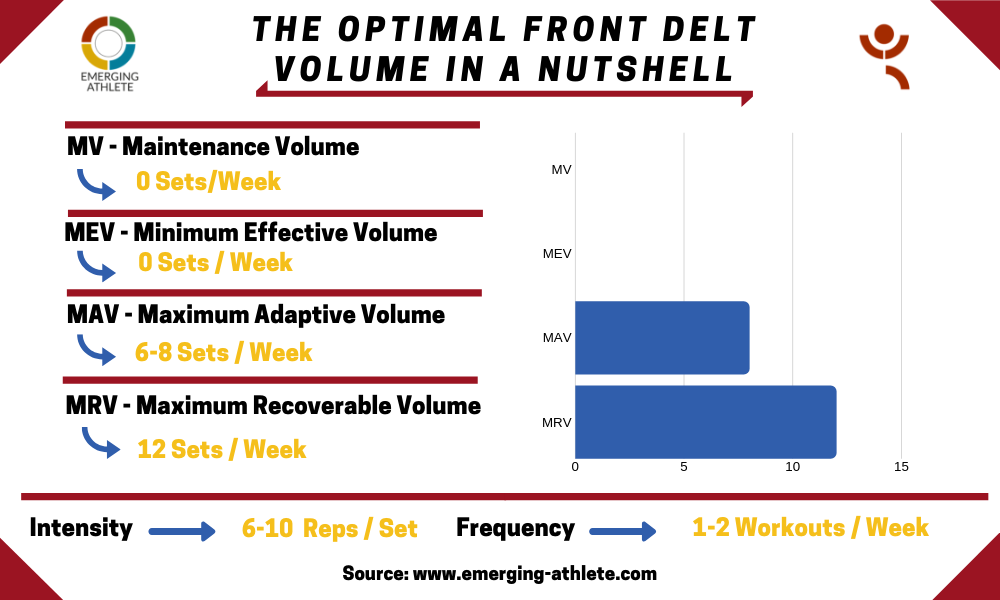6Continuing our optimal volume article series, the next three articles will demonstrate the important parameters about the front, side, and rear delts.
If you’re not yet familiar with volume, how it affects your muscle growth and what you should hold in your head, check out our complete guide about the optimal volume for hypertrophy.

Before we start, as a short preview, what can you expect from this article series?
Based on Dr. Mike Israetel’s knowledge and the experience that we gained on our own journey and from working with clients, we want to clarify the most important criterion for muscle hypertrophy.
Alright, off we go.
I assume that most of the people who train regularly seek for that nice looking 3D shoulder appearance.
But does tons of front delt work actually brings you closer?
Too many people play too much attention to their front delts while neglecting the more important side and rear delts.
This article will go more in-depth about parameters that do really matter for the optimal front delt volume.
MV – Maintenance Volume
Why is it important to know your MV?
Imagine you need to take a break from training for any reason or for some during vacation. Not that big of a deal, but what if you don’t want to expose as much time to fitness as back home?
Do you want to lose your hard acquired gains? Right, who would want that?…
Likewise, after weeks and weeks of heavy workouts in between your MAV and MRV or even above your MRV, it is for sure a good thing to lower your volume from time to time to desensitize your body.
This way you’re renewing the body’s capability for being responsive to stimuli.
As you can see, it is crucial to know where your MV lies to ensure muscle maintenance and moreover, stick to the appropriate “deload phase” volume.
If you’re wondering what a deload is, don’t panic. I wrote a whole article about that topic, just click the highlighted link to dive into it.
How much volume do the front delts need to maintain their current size?
MV: 0 sets/week
Wait a minute… How can that be true?
Simple. When working out chest and triceps, almost every push exercise, especially with an incline angle strains front delts to a good amount.
This means people who train their chest at least two times per week, you don’t need to put much effort into isolation front delt work.
Such small muscles as the front delts really get fatigued fast. Particularly heavy chest exercises like bench press demand a lot of energy.
MEV – Minimum Effective Volume
Why is it important to know your MEV?
Simple and relatively straightforward.
As well as it is important to know how much volume your front delts need to keep its current size, it is at least of similar importance to know how much volume is required to grow your front delts.
How much volume is required for the Minimum Effective Volume?
MEV: 0 sets/week
In this case, the MV and MEV are equal. For both a volume of around 0 sets/week is enough to maintain or even grow your front delts.
How is that possible?
It applies the same explanation as just stated above.
Due to the facts that front delts get involved in a great range of push exercises (e.g. all variations of bench press or overhead press) a lot of fatigue is accumulated to stimulate growth.
Unless your genetical predisposition or training history regarding front delts seems to be different, most individuals don’t need any additional isolation work for their MV or MEV.
But of course, if you feel like they lag behind compared to the other parts of your shoulders or just out of pleasure, you can train them more often.
These are merely landmarks that should be used accordingly.

MAV – Maximum Adaptive Volume
Why is it important to know your MAV?
Who wants to keep their training efficiency at a mediocre level?
I suppose nobody, right?
In order to get the best possible gains, apparently, it is not sufficient to just let them slide besides. We need to put in more energy. Accordingly, it is important to know where your MAV lies to maximize your muscle growth effect.
What’s the reference value for the front delts MAV?
MAV: 6-8 sets/week
If you notice that your side, rear delts, and front delts come off badly compared to your chest, you can definitely add some isolation work into your programme.
Besides your actual push workout (chest, triceps, shoulders), a volume of around 6-8 sets/week will stimulate sufficient growth.
MRV – Maximum Recoverable Volume
Sooner or later in your mesocycle program, you’ll get to a point where your performance starts to stagnate or even decrease. This is an indication that you probably overreached your MRV.
What does that mean?
The MRV refers to the Maximum Recoverable Volume from that your body can recover properly.
Briefly speaking, the maximum amount of work that you can sustain before strength and performance might decrease as result of extensive fatigue and soreness.
Why is it important to know your MRV?
Pretty obviously, nobody wants to take a forced break from training just due to being hubris with your volume.
Therefore, it is very essential to know where your MRV lies to keep your body recovered and avoid superfluous breaks.
Thus, what is a good volume that is still recoverable?
MRV: 12 sets/week
Probably around 12 sets/week comes close to the MRV for most people. Now some of you might think, 12 sets/week that isn’t really a lot, right?
Certainly, it’s not, but we really need to take into consideration the basic push work that your program includes.
If you’re doing tons of flat, incline, and overhead press, all of those demand the front delts heavily.
Now imagine, you add 12 sets/week of isolation front delt work on top of that.
Exactly, because its 12 sets of direct isolation work along with your heavy push exercises, most people probably aren’t able to recover much higher volumes.
Eventually, on average the MRV lies at 12 sets/week.
As always there are exceptions who can bear more volume but for the average guy who doesn’t compete but just seeks to stay fit, this certainly is enough.
Frequency
How often should I train for the optimal front delts volume?
1-2 workouts/week
So far we already noticed that the actual push workout exerts a big influence on the optimal front delt volume. This continues to even go beyond.
Whereas on average for most muscles I recommend a frequency of about 2-4 workouts/week, this case is different. For the optimal front delt volume, 1-2 workouts/week tend to work just fine.
The point is that all the heavy push exercises, don’t matter if its bench press, incline press or overhead press, especially for heavy lifters, take quite a long time to recover.
Furthermore, every time you train chest movements which are not direct work for the front delts (like the overhead press) still hit them. This at the very least conserves them if not gives them an additional stimulus.
On that note, front delt isolation work only needs to occur 1-2 times/week. According to what I’ve just said, this results in 4-6 times/week composed of 1-2 additional isolation workouts along with your current push workout.
Intensity
How intense should I train for the optimal front delt volume?
In between 6-10 reps on average
Front delts seem to be composed of muscle fibers that do not respond well to high burnout rep ranges. Instead, various people genuinely experienced really good growth with heavier forces (about 8 reps on average).
Anything above 10 reps, there are two things likely to happen. First, your delts just get tired over time and second is that your triceps tires out and consequently will be the limiting factor rather than your front delts.
Front delt workout – Exercises
Let’s take a closer look at the actual front delt workout.
What is important to know for the optimal front delt volume with regard to exercise selection?
Actually, there isn’t really anything special about it. There are two common movements which are used to train our front delts.
Raise movements:
For example…
- Cable front raise
- Dumbbell front raise
- Barbell front raise
Overhead pushing movements:
For example…
- Military Press
- Shoulder Press (Dumbbell/Barbell
- Overhead Press
- Arnold Press
- Handstand Push Up
As you can see, there are mainly two movements. A good thing to do would be implementing exercises of both kinds into your training program.
I can recommend starting with a heavier compound exercise (e.g. shoulder press, military or overhead press) and afterwards finish off/follow up your front delt workout with some lighter cable raises.
Range of Motion
Is the range of motion important for the optimal front delt volume?
Especially when it comes to shoulder workout, it is very important to pay attention to your elbows, joints, and shoulders.
For that reason, yes, range of motion is substantial!
Hence, we advise taking whatever barbell, dumbbell or machine all the way down for a deep stretch. Most people can even touch the barbell to their clavicle and push it all the way overhead.
That allows you to use the smallest amount of weight to actually generate high forces and especially high workloads to keep the shoulder mobile.
Furthermore, if you use overhead press movements with the full range of motion, you’ll be less susceptible to shoulder injuries.
Conclusion
Before we wrap it all up with a nice overview of the optimal front delt volume, just some short advice for you, guys.
After we’ve talked quite a lot about our front delts now, I hope that everybody understood front delts really don’t need as much attention to grow as other muscles.
Instead, you should focus more on developing your chest, triceps, side and rear delts. In most cases, the front delts really keep care of themselves through your regular push workouts.
You don’t want to spend a lot of time doing isolation work for your front delts and ending up with huge front delts whereas your chest, side and rear delts lag behind, trust me…
This could really cause issues such as having difficulties to properly feel your chest. Likewise, you’re more susceptible to injuries and doesn’t even look that good.
Nevertheless, you can add some isolation work for your front delts occasionally, but you should definitely prioritize other muscles.

Exercises: We can identify two common movements for the front delt workout. 1) raise movements (cable raise, front raise) and 2) overhead pushing movements (military press, shoulder press, overhead press).
I would recommend implementing both types of exercises to stimulate the best possible growth and combine the benefits.
Range of motion: The optimal front delt volume tremendously benefits from a proper range of motion.
Why?
It allows you to use the smallest amount of weight to actually generate really good forces and keep the shoulder mobile. This also reduces your susceptibility to shoulder injuries.
Practical Tips
In this section, we’ll give you some practical tips for the optimal front delt volume that you can implement from time to time into your training program. This will help you to stimulate new incentives.
In the following, these are all techniques that worked quite well for plenty of people and can be recommended from our own experience, too.
Giant sets: You set a certain number of reps.
For example, in this case, 60 reps for the overhead press.
In your first set, you did 15 reps, second one 12 reps, third one 10 reps and so on.
You continue this until you reached the intended rep number (60 reps of the overhead press).
Special shout-out to Dr Mike Israetel, we really value his knowledge and the content that he shares with you guys on his YT channel and his blog.
Definitely check out his video about front delt volume!
Do you put a lot of effort into your front delts training?
If this article about the optimal front delt volume helped you, we would highly appreciate if you can share it with your friends and family.
Let us know about your personal experiences as long as
For any further questions, you can reach us through our social media channels. We’re pleased to help you out!
See you next time!
Claas





